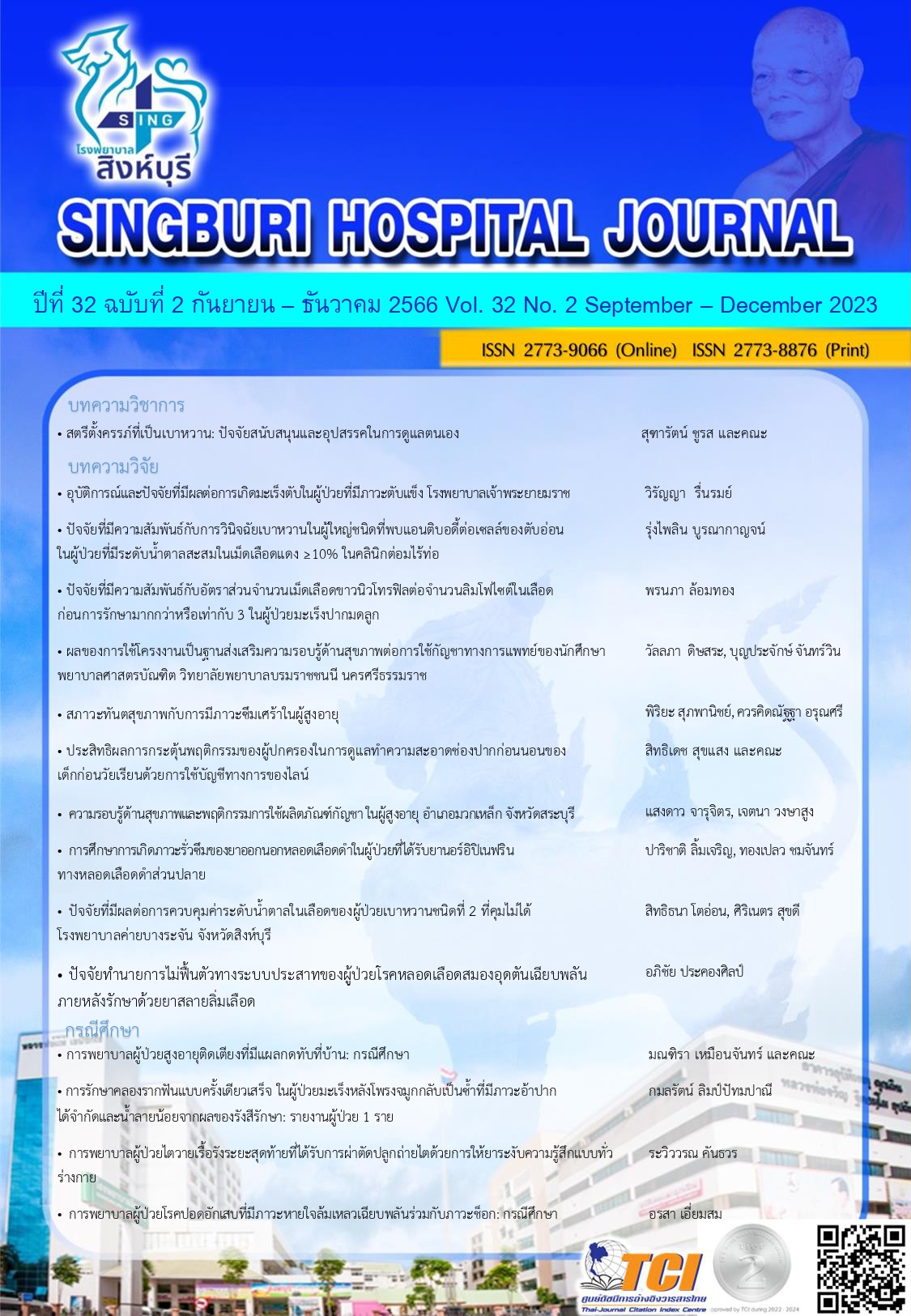การพยาบาลผู้ป่วยสูงอายุติดเตียงที่มีแผลกดทับที่บ้าน: กรณีศึกษา
คำสำคัญ:
การพยาบาล, การรักษาบาดแผลขั้นสูง, ผู้ป่วยติดเตียง, แผลกดทับบทคัดย่อ
แผลกดทับเป็นปัญหาที่พบได้บ่อยในกลุ่มผู้ป่วยที่มีความบกพร่องทางการเคลื่อนไหว โดยเฉพาะผู้ป่วยสูงอายุติดเตียง การเกิดแผลกดทับทำให้เกิดภาวะแทรกซ้อนที่สำคัญ คือ การติดเชื้อที่แผล (Infection wound) ส่งผลให้ผู้ป่วยต้องนอนพักรักษาตัวในโรงพยาบาลนานขึ้น โรงพยาบาลต้องสูญเสียทรัพยากรในการดูแลผู้ป่วยเพิ่มขึ้น นอกจากนี้การเกิดแผลกดทับทำให้ผู้ป่วยและญาติได้รับความทุกข์ทรมานทั้งด้านร่างกายและจิตใจ โดยเฉพาะแผลกดทับที่ติดเชื้ออาจมีความรุนแรงจนทำให้ผู้ป่วยถึงขั้นเสียชีวิตได้ พยาบาลเป็นอีกวิชาชีพหนึ่งจึงที่มีบทบาทสำคัญในการรักษา ฟื้นฟูและป้องกันภาวะแทรกซ้อนจากแผลกดทับ ซึ่งการดูแลผู้ป่วยที่มีแผลกดทับที่บ้านสามารถช่วยลดการเกิดภาวะแทรกซ้อนจากการติดเชื้อที่แผลในโรงพยาบาลได้ การสร้างเสริมสุขภาพผ่านกระบวนการคุณภาพเพื่อการเปลี่ยนแปลงที่ยั่งยืน (SHA: Sustainable Health Care and Health Promotion By Appreciation and Accreditation) จึงมีความสำคัญในการดูแลผู้ป่วยในชุมชน โดยมีเป้าหมายหลักในการรักษาแผลกดทับ คือ การทำให้บาดแผลหายดี ใช้ระยะเวลาน้อยที่สุด ซึ่งมีครอบครัวหรือผู้ดูแล (Caregiver) เป็นผู้ดูแลหลัก โดยมีพยาบาลเป็นผู้ให้คำปรึกษา จากกรณีศึกษานี้ใช้การรักษาที่เรียกว่ารักษาบาดแผลขั้นสูง (Advance wound care) โดยเลือกใช้วัสดุสำหรับการดูแลบาดแผลหลายชนิด เพื่อช่วยเพิ่มประสิทธิภาพในกระบวนหายของแผล ลดการอักเสบหรือติดเชื้อ ลดระยะเวลาในการรักษาบาดแผล ลดการกลับเข้าไปรักษาที่โรงพยาบาลซ้ำจากภาวะแทรกซ้อนของแผลกดทับ โดยยึดหลัก SHA เพื่อให้เกิดการบริการสุขภาพและส่งเสริมสุขภาพที่ยั่งยืน
Downloads
เอกสารอ้างอิง
Gefen A, Brienza DM, Cuddigan J, Haesler E, Kottner J. Our contemporary understanding of the aetiology of pressure ulcers/pressure injuries. International Wound Journal 2021;12:1-13.
Zhaoyu Li, Frances Lin, Lukman Thalib and Wendy Chaboyer. Global prevalence and incidence of pressure injuries in hospitalized adult patients: A systematic review and meta-analysis. International Journal of Nursing Studies. 2020;105:103546: 1-13.
Nguyen HM, Le TTN, Nguyen AT, Lea HNT, Pham TT. Biomedical materials for wound dressing: recent advances and applications. RSC Adv 2023;13:5509–28.
Jiamtanopachai R And Sanveingchan S. Nursing practice guidelines for the prevention of pressure ulcers. Thai Journal of Nursing 2018;67(4):53-61.
Lavin W, Yooyadmak P, Praepataraprasit R. The nutritional status and association of new pressure ulcer in patients who transfer from in-patient ward to intensive care unit (ICU). Journal of Nursing Science & Health 2017;43(3):162-71.
Kottner J, Black J, Call E, Gefen A, Santamaria N. Microclimate: a critical review in the context of pressure ulcer prevention. Clinical Biomechanics 2018; 59:62-70.
Mamom J, Rungroungdouyboon B, Chuanasa J. Enhancing the quality of long-term patient care by use of the innovative electrical bed-turning system for the prevention of pressure injuries: A pilot study. Science and Technology Asia 2022;27,1-19
Chiaprasert S, Dumsangsawad N, Yok-in J, Junwin B. Pressure sore prevention of person with cerebrovascular disease at home: The caregiver development in Thailand 4.0 era. The Journal of Faculty of NursingBurapha Universit 2020;28(1): 107-15
Whitty JA, McImmes E, Bucknall T, Webster J, Gillespie B., Banks M. The cost-effectiveness of a patient-centred pressure ulcer prevention carebundle: Findings from the INTACT cluster randomised trial. International Journal of Nursing Studie 2017;75:35-42.
Uccioli L, Meloni M, Vainieri E, Ruotolo V, Giurato L. Non-healing Foot Ulcers in Diabetic Patients: General and Local Interfering Conditions and Management Options with Advanced Wound Dressings. Journal of wound care 2015;24:35-42.
Ousey K, Rogers AA, Rippon MG. Hydro-responsive wound dressings simplify T.I.M.E. wound management framework. Community Wound Care 2016;11:39-49.
Dabiri G, Damstetter E, Phillips T. Choosing a wound dressing based on common wound characteristics. Adv Wound Care 2016;5: 32–41
Boonpadung D. Spiritual Health Care [Internet]. 2560 [cited 2023 Apr 10]. Available from: http://km.fsh.mi.th/wp-content/uploads/2012/ 12/SHA_1.pdf
Kerr A. Multifunctional and patient-focused Mepilex Border Flex: an exploration of its holistic clinical benefits. Journal of Wound Care 2019;28:4-31
Pheetarakorn P. Nursing care of the patients with Pressure injury: Nurse’s Role. Hua Hin Medical Journal 2021;1(1):1-16
Rippon MG, Ousey K, Cutting KF.Wound healing and hyper-hydration: a counterintuitive model. J Wound Care 2016;25:68–75.
Dissemond J. Non-healing surgical wound with exposed bone: Case studies. Journal of Wound Care 2020;29:11-13.
Walkera RM, Gillespieb BM, McInnesc E, Moored Z,. Eskesi AM, Pattonk D, Harbeckn EL, Whiten C, Scotto IA, Chaboyerp W. Prevention and treatment of pressure injuries: A meta-synthesis of Cochrane Reviews. Journal of Tissue Viability 2020;29:227–43.
McKenzie JF, Neiger BL, Thackeray R. Planning implementing and Evaluating Health promotion program. 8 editions. United States of America: World headquarter; 2023.
The Healthcare Accreditation Institute (Public Organization). Development of spiritual healthcare in action (sha). 1 editions: Famous & Successful; 2022.
ดาวน์โหลด
เผยแพร่แล้ว
รูปแบบการอ้างอิง
ฉบับ
ประเภทบทความ
สัญญาอนุญาต
ลิขสิทธิ์ (c) 2023 โรงพยาบาลสิงห์บุรี

อนุญาตภายใต้เงื่อนไข Creative Commons Attribution-NonCommercial-NoDerivatives 4.0 International License.
บทความที่ได้รับการตีพิมพ์เป็นลิขสิทธิ์ของโรงพยาบาลสิงห์บุรี
ข้อความที่ปรากฏในบทความแต่ละเรื่องในวารสารวิชาการเล่มนี้เป็นความคิดเห็นส่วนตัวของผู้เขียนแต่ละท่านไม่เกี่ยวข้องกับโรงพยาบาลสิงห์บุรี และบุคคลากรท่านอื่นๆในโรงพยาบาลฯ แต่อย่างใด ความรับผิดชอบองค์ประกอบทั้งหมดของบทความแต่ละเรื่องเป็นของผู้เขียนแต่ละท่าน หากมีความผิดพลาดใดๆ ผู้เขียนแต่ละท่านจะรับผิดชอบบทความของตนเองแต่ผู้เดียว







